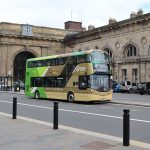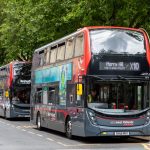The already extensive choice of used double-deckers will get bigger soon when several Scania-based examples drop onto the second-hand market from Reading Buses. They’re ready to go back to work
The quandary of what to do when you need a high-capacity double-decker for school work has no single correct answer, but most operators usually go for a mid-life model with plenty of life left in it. And that’s what will soon be available from Reading Buses’ fleet.
From next month, it will have a variety of Euro 4 Scania-based ‘deckers for sale. Nine are 2007- and 2008-registered models with East Lancs Olympus bodies built on N 230 UD chassis, and six are from 2008 with Scania’s own OmniCity body mounted on CN 270 UD underframes.
All have a sticker price of £65,000, says Head of Engineering and Innovation John Bickerton, but there is potential to reduce that figure in cases of multi-vehicle purchases.
And while they are ideal for school duties, they could also return to front-line service with little difficulty.
Reading Buses has a well-won reputation for its standard of maintenance and fleet presentation, and the buses have been well looked-after. All were new with one door and they have not been converted from centre exit layout.
routeone was recently able to put one of the East Lancs-bodied examples to the test. Like the OmniCitys, they all have a good level of specification; a colour CCTV monitor in the cab coupled to a Synectics T800 camera system will remain (albeit without the hard drive), as will the colour Hanover LED destination display equipment that includes a full-width rear screen
All of the buses will come with at least three months’ MoT and various tyre options are available, including retaining the Michelin rubber that they are currently shod with.
The test bus was first registered in February 2008. It has 51 seats on the upper deck and 28 downstairs for a total of 79, and it can carry a further 10 standees. If PSVAR compliance is no longer required, upseating will be an option.
Build
All of the buses available are full-height. The East Lancs examples are 4.3m tall and they have over 6ft of headroom on the lower deck. The upper saloon is less spacious but it is acceptable nonetheless. Other dimensions are 10.6m long and 2.52m wide.
Scania’s driveline arrangement places the engine on the offside and the gearbox on the nearside, the reverse of most other double-deck chassis.
The radiator, unusually, is mounted above the engine; that gives the positive of removing it from where it may collect road dirt and debris and assuring a good flow of clean air, but on the other hand it means that no rear window is fitted on the lower deck.
The fuel tank is mounted over the offside front wheel, and the staircase is compact. Unladen weight is 12,040kg and the plated GVW is 17,800kg.
As would be expected of a bus that has spent 10 years in heavy urban traffic, the odd minor scrape and dent is present.
The most susceptible area – the lower panels amidships – are completely free from damage on the test bus, however, and thus no repanelling will be necessary there.
Steel wheels are fitted with 275/70 R22.5 tyres. All of the buses have battery guards and they are also equipped with cab air-conditioning.
Power is from an 8.9-litre, five-cylinder 230bhp Euro 4 DC09 engine coupled to a five-speed ZF Ecomat gearbox; the OmniCitys have the same engine, but rated at 270bhp. It uses EGR to achieve Euro 4 and no ad-blue is required.
Passenger access
Access is standard for a double-decker and a manual book leaf wheelchair ramp is within the doorway. Naturally, kneeling front suspension is fitted. Reading Buses specifies separate buggy and wheelchair areas. The latter is on the nearside behind the front wheel
Within this bay are four tip-up seats, and the buggy area opposite contains three of the same kind; they are among the 13 lower deck positions that can be accessed without reaching a step, although the gangway is flat until behind the rear axle.
There is potential to increase capacity by replacing the tip-ups with conventional seating, although that would come at the expense of PSVAR certification.
Handrails are finished in silver and bell pushes are numerous. On both decks, the gangway is picked out in red; the remainder of the floor is blue. Stairs are also finished in red with yellow edges, and the staircase is to a compact layout that changes direction twice as passengers ascend.
Passenger comfort
The seats in the test bus are Fainsa’s Gala type, and they are covered in blue moquette. Some are sagging slightly, and they would benefit from replacement foam and re-covering. The OmniCitys that are available have already had that work done.
The floor also shows signs of heavy use, but here perhaps a deep clean would be all that was required. Side panels and the like are OK, and the bus is free from vandalism. That, says John, is thanks to the fitment of wi-fi.
The body benefits from twin opening hoppers at almost every window, and that should provide good ventilation on warm days.
When the weather is not so good, the heating system – which is made up of twin perimeter radiators on the lower deck and a nearside unit upstairs – does its job well, and the lower saloon was warm by the time the test drive was over.
However, the DC09 is a large engine, and it takes time to reach operating temperature in slow-speed traffic. As a result, saloon heat is certainly not immediate, but when it arrives, it will keep passengers at a comfortable temperature.
Travelers that sit at the front of the upper deck benefit from a very low windscreen and a side window that tapers downwards. That gives a panoramic vista from the prized position.
Driver comfort
As is usually the case in a Scania, the driver has a comfortable time of it. A sprung seat is finished to match those in both saloons and the cab air-conditioning will be welcome.
Controls are logically laid out, and the handbrake and door buttons are close to hand. Seat adjustment is good and there is space for a bag, and the steering wheel moves via a locking switch on the column.
The buses have full-length anti-assault screens, but it would be possible to remove them for their next life. Rattles in and around the cab come largely from that screen and from the farebox.
Visibility is good enough, but the A- and B-pillars are close together and when combined with the driving position they create a modest blind spot. Care will be necessary when looking out for cyclists at junctions and roundabouts.
Like the saloons, the cab shows signs of heavy use, and a deep clean here would be worthwhile. Other than these points, there is little more to say; it is a standard bus cab and drivers will quickly become familiar with it.
Performance
The Euro 4 DC09 displaces 8.9 litres, a lot by current standards, but at 12,040kg unladen the bus is somewhat heavier than newer models that have followed it.
Performance is as would be expected; the Scania has no problem keeping up with urban traffic and it is sharp off the mark when traffic permits. In urban service, the buses have recorded fuel consumption of 6.5mpg.
While Reading is not over-endowed with hills, performance on one that was encountered was good and on a stretch of dual-carriageway, the bus proved capable of 55mph with no complaint.
That’s a benefit of going for a larger engine. Some operators’ experience shows that a small unit may work well in the urban setting, but when prolonged high-speed running is required, they can be found lacking. As a school bus is likely to also undertake an amount of private hire work, that’s something to be considered.
Although the Scania has been well-used in Reading, its driveline is still generally smooth. As with some Ecomat gearboxes, shift quality can be a little variable during the warm-up phase, but once the transmission fluid has reached operating temperature, things improve markedly.
Manoeuvrability is good thanks to the modest wheelbase, but the driver sits a way back from the windscreen.
As a result, it will be necessary to take care when using saw-tooth bus stations to ensure that the lower dash is not damaged; it is not as easy as on some other models to gauge exactly where it is from the driving seat.
Verdict
There is no shortage of used mid-life double-deckers for sale, and as a result it’s definitely a buyer’s market.
The Reading Scanias come in a condition that makes them ready to be put back to work immediately, although most operators would have them repainted before further use and some will also carry out a degree of interior tidying – be it a deep clean or a full refurbishment.
There is no denying that the buses have been heavily utilised in their first lives, but they have been looked after well. Bodywork condition of the test vehicle is good, as is the driving experience, and the traveling environment is also pleasant if the predictable wear and tear is taken into account.
Scanias have always been regarded as buses that are capable of long lives, and there is no reason to doubt that those shortly available from Reading will be any different. The DC09 engine is under-stressed on urban work, and various exhaust after-treatment units can be added for applications where emissions are a consideration.
A repaint, a retrim, a deep clean and perhaps a cherished number plate, and this bus and its sisters have many years of work left in them.
For more information, email johnbickerton@reading-buses.co.uk.

























